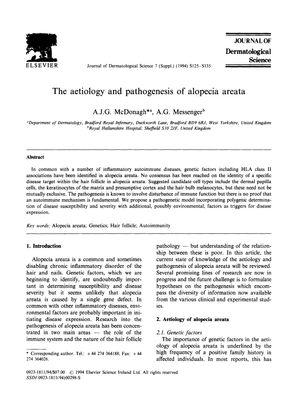The Etiology and Pathogenesis of Alopecia Areata
July 1994
in “
Journal of Dermatological Science
”
alopecia areata genetic predisposition HLA class II polygenic immune system abnormalities T lymphocyte infiltration autoimmune diseases hair follicle changes keratinocytes telogen hairs stress identical twins HLA types DEBR mouse C3H/HeJ mouse hair loss genetic factors immune system autoimmune conditions hair follicle stress

TLDR The cause of alopecia areata is likely a mix of genetics, immune system issues, and environmental factors, with more research needed to understand it fully.
The 1994 document reviews the etiology and pathogenesis of alopecia areata, suggesting a complex interplay of genetic, immunological, and possibly psychological factors in its development. It highlights genetic predisposition, with familial incidence ranging from 10% to 42% and associations with HLA class II, and considers the disease to potentially be polygenic with environmental triggers. The paper notes inconsistent patterns of immune system abnormalities, including activated T lymphocyte infiltration, and associations with other autoimmune diseases. It also discusses hair follicle changes, such as vacuolation in keratinocytes and malformed telogen hairs, and the role of stress and other factors in disease onset. The document underscores the need for further research to clarify the genetic and immune mechanisms involved, referencing studies on identical twins, HLA types, and animal models like the DEBR and C3H/HeJ mouse to support the autoimmune hypothesis.

